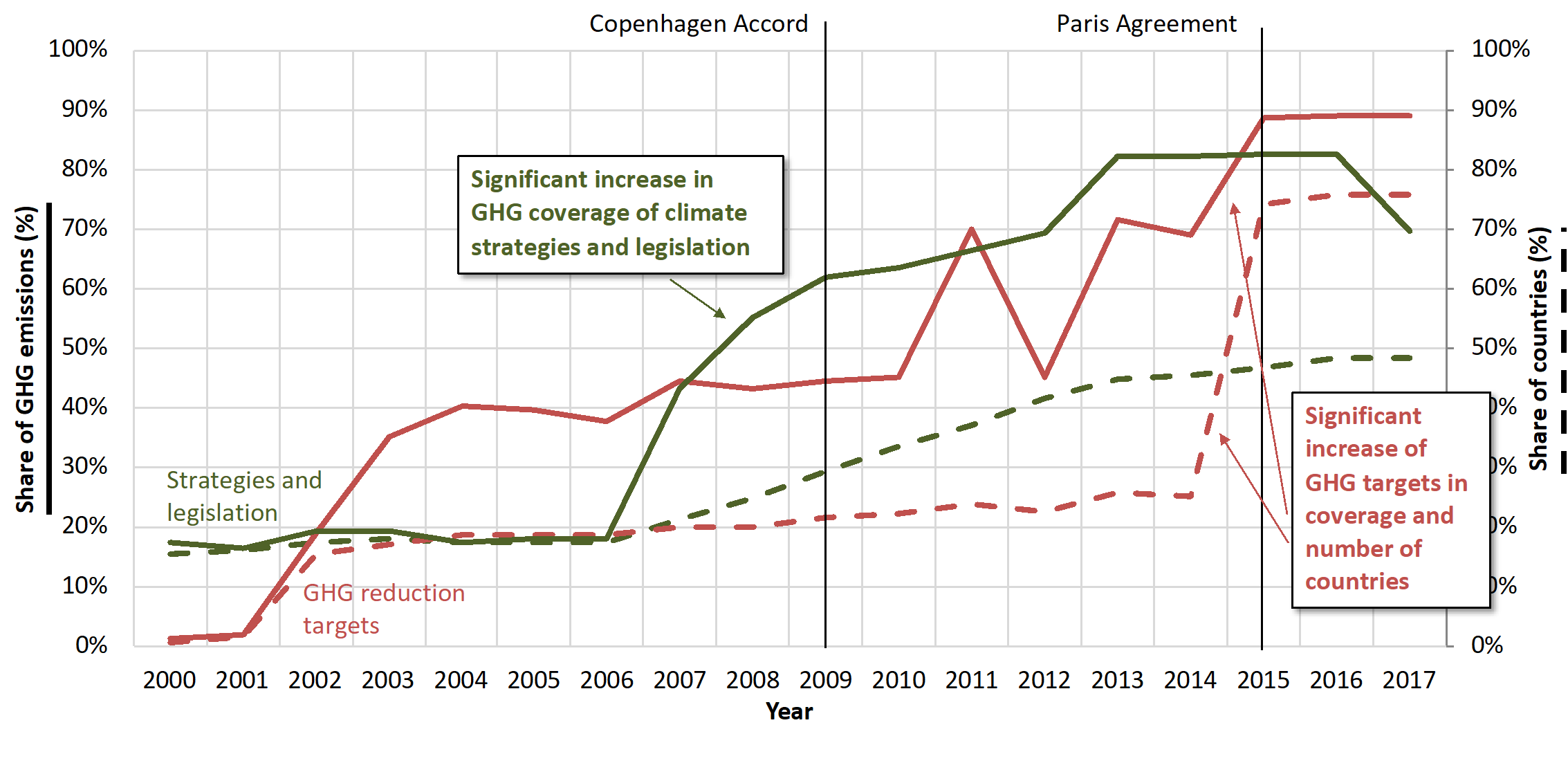Our new study published by Climate Policy finds that national climate action has spread rapidly, and that this spread is strongly coincident with landmark international agreements. Following the Paris Agreement, 89% of global greenhouse gas (GHG) emissions (76% not counting USA) are covered by pledged national GHG reduction targets, a near universal coverage. Moreover, more than two thirds of global emissions are covered by national climate legislation or strategy, a development strongly shaped by negotiations around the Copenhagen Accord. While national actions are, as yet, insufficiently stringent, this broad coverage is an important step forward.

Figure 1: Share of countries (out of 194) and share of GHG emissions covered by climate mitigation legislation, strategies and GHG emissions targets.
A quarter of a century since the adoption of the United Nations Framework Convention on Climate Change (UNFCCC), the world is still not on a sufficiently rapid GHG reduction path to avoid catastrophic global warming. In fact, even the full implementation of current conditional and unconditional Nationally Determined Contributions of countries under the Paris Agreement would set the world on about 3oC temperature increase by 2100.
Starting around the Copenhagen COP of 2009, efforts at global climate governance have shifted from a top-down approach to the hybrid, predominantly bottom-up approach of the Paris Agreement adopted in December 2015. This new architecture shifts the emphasis to national actions, and requires a research agenda focused on understanding national climate legislation, strategies and targets. Our study published in Climate Policy tracked the adoption of economy-wide legislation, strategies and targets for climate change mitigation from 2000 to 2017 in 194 countries, covering nearly all the countries subscribed to the UNFCCC. We find that:
- The number of countries that have national legislation and strategies in place increased strongly up to 2012, but the increase has levelled off in recent years, now covering 70% of global emissions by 2017 (48% of countries and 76% of global population).
- Economy-wide GHG reduction targets witnessed a strong increase in the build-up to 2015 and are adopted by countries covering 89% of global GHG emissions (76% not counting USA) and 90% of the global population (86% not counting USA) in 2017.
- Renewable energy targets saw a steady increase throughout the last decade with coverage of countries in 2017, comparable to that of GHG targets (79% GHG emissions coverage).
- Despite data coverage limitations, we found that energy efficiency targets were adopted in 59 analyzed countries, which amounts to 69% of countries for which energy efficiency target data was available.
Key shifts in national climate measures coincide with landmark international events (Figure 1). For instance, a sudden increase in GHG emissions covered by legislation and strategies between 2004 and 2009 led by Non-Annex I parties was driven by new legislation and strategies put in place by developing countries with high GHG emissions levels in the build-up to the Copenhagen Climate Conference. Similarly, a large number of countries adopted GHG emissions targets just before the Paris Climate Conference in 2015, stimulated by the request for provision of Intended Nationally Determined Contributions. International processes have likely been significant in stimulating changes at the national level toward denser structures of climate governance. While the impact of these changes depends on their stringency and implementation, the introduction of legislation, strategy and targets are an important necessary step.
The withdrawal of the USA from climate policy runs contrary to the global trend. The abandonment of the US climate strategy by the Trump administration reduced GHGs covered by climate legislation or strategies from 83% to 70%. Coverage of GHGs under a target would decrease from 89% to 76% if the US cancels its NDC target under the Paris Agreement.
The large share of GHG emissions covered by domestic legislation, strategies and targets is an important step and shows substantial progress over the past decade, stirred by the international global negotiations. However, beyond goal setting and planning, it is now essential to ensure an effective implementation of strategies and targets through adequate national climate mitigation measures and extension of those measures consistent with enhanced ambition.






